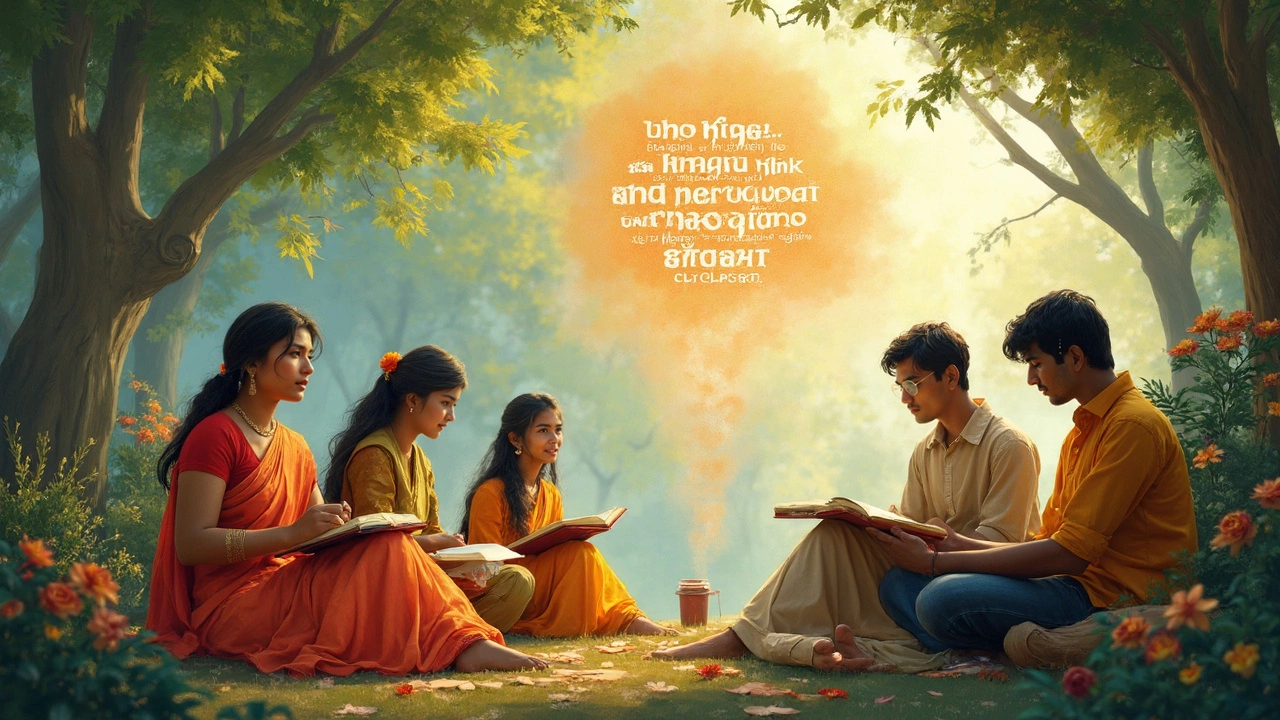Who is the Mother of Indian Poetry? Tracing the Roots of Short Poems in India
 Apr, 24 2025
Apr, 24 2025
The phrase “Mother of Indian Poetry” gets tossed around a lot, but few stop to ask who really earned it. Most people point straight to Sarojini Naidu. She’s not some dusty figure from a forgotten era—her poems are still read in schools, quoted at gatherings, and shared online today.
Naidu wasn’t just good at stringing words together. She broke into a scene that was heavily male-dominated back in the early 1900s. Her style? Short, vivid, and easy to relate to. Instead of complicated ideas, she went for feelings—love, freedom, pain. That clicked with readers who wanted something real, not just lines to memorize for exams.
- Why Sarojini Naidu is Called the Mother of Indian Poetry
- How Her Work Changed Short Poems in India
- Reading Naidu: What to Look Out For
- Tips to Try Writing Short Poetry Yourself
Why Sarojini Naidu is Called the Mother of Indian Poetry
If you ask around about the mother of Indian poetry, almost everyone brings up Sarojini Naidu. She’s not just popular because of her poems, but also because she opened doors for Indian women in literature. She published her first book, 'The Golden Threshold', in 1905 when hardly any Indian women even thought of writing in English.
Her writing didn’t stick with just pretty lines—it dived into stuff everyone cares about, like love, family, struggle, and especially freedom. Even Mahatma Gandhi called her the ‘Nightingale of India’ for how she mixed art with activism. Her poems gave people hope when the country was fighting for independence.
Get this—her work was so widely read that even in early 1900s England, newspapers called her writing fresh and fearless. While a lot of others were copying British poets, Naidu put Indian life, festivals, and women’s rights right into her short poems. She was representing real lives in real words.
Here’s a quick look at how her poetry took off:
| Year | Milestone |
|---|---|
| 1905 | ‘The Golden Threshold’ published |
| 1912 | ‘The Bird of Time’ released |
| 1917 | ‘The Broken Wing’ launched |
She even wrote poems about little everyday things—flower sellers, street musicians, and ordinary women. Instead of big myths, she showed small moments. That’s what made her a household name and why schools still teach her short poems today. Sarojini Naidu stands out because she made Indian poetry something everyone could relate to, not just academics or old-school poets.
How Her Work Changed Short Poems in India
Before Sarojini Naidu got on the scene, Indian short poetry in English was rare, and when it showed up, the style was super stiff and felt far away from daily life. She took those old ways and turned them upside down. Her poem "The Bangle Sellers" isn’t just part of school textbooks by chance—it’s famous for how it makes you see people and feel what they feel, using just a handful of carefully chosen words.
Naidu’s real game-changer was the way she fused Indian themes with the English language. British poets at the time stuck to their world, but Naidu wrote about Indian colors, festivals, daily street sounds, and people’s simple joys and struggles. She made short poems that didn’t just sound nice—they felt real and close to home. Here’s why her style caught on and still matters:
- Relatable Topics: She talked about everyday things—flowers, nature, festivals—that nearly every Indian could instantly connect with.
- Simple Language: No complicated words or ideas; she wanted her poetry to be for everyone, not just academics or elites.
- Strong Imagery: She could describe the smell of spices or the noise in a bazaar in just a few lines, and you’d feel like you were actually there.
- Breaking the Rules: She ditched traditional English forms and made poems that had their own rhythm—sometimes following a pattern, sometimes just flowing naturally.
Looking at the impact, more and more Indian writers started using their own culture and identity in their poems, even when writing in English. Here’s a quick peek at how the number of published Indian short poetry works in English grew once Naidu’s books hit the shelves:
| Decade | Number of Books by Indian Poets (English, Short Poetry) |
|---|---|
| 1890s | 2 |
| 1900s (Naidu's debut) | 8 |
| 1910s | 16 |
| 1920s | 37 |
Her courage to write “Indian” poems in English basically paved the way for hundreds of poets, making Indian short poetry its own thing. If you spot any poem that talks about the real India in simple but touching words, chances are there’s a little of Naidu’s spark in it.

Reading Naidu: What to Look Out For
If you're trying to get what made Sarojini Naidu the "mother of Indian poetry," don’t just skim her poems—read them with a real eye for detail. One thing people always notice is how short and punchy her poems are. You won’t get lost in a maze of words. Each line pulls you straight into the emotion or picture she wants you to see.
She had this way of tapping into everyday life—street vendors, marketplaces, and moments at home—and it shows up a lot in her work. Poems like “The Bangle Sellers” and “Coromandel Fishers” are classic examples. When you read, look for these common signs it’s Naidu:
- Simple language: No frills, but still powerful.
- Song-like rhythm: Reading her work out loud almost feels natural, like singing.
- Strong Indian flavor: References to Indian traditions, people’s jobs, even festivals. It feels close to home if you’re from India, and gives others a window into that world.
- Emotions in focus: Her short poetry gets straight to the heart—dreams, freedom, longing.
Her poetry stands out partly because she wrote in English at a time when it wasn’t the norm for Indian poets, especially women. Still, her voice never sounds "Western." She brought a genuinely Indian touch to every line. It’s no wonder schools in India—and sometimes even the UK—still teach her poems today.
Here’s a quick look at the themes you’ll spot in her most popular poems:
| Poem | Main Theme | Why It Matters |
|---|---|---|
| The Bangle Sellers | Everyday women’s lives | Shows respect for working women in Indian society |
| Coromandel Fishers | Freedom & labor | Sheds light on struggles and hope in daily work |
| In the Bazaars of Hyderabad | Cultural richness | Puts color and energy of Indian markets on paper |
So, if you’re checking out Indian short poetry or learning about Indian poets, Naidu’s work is a must-read. Notice her mix of culture, emotion, and simplicity. That’s where her poetry really shines.
Tips to Try Writing Short Poetry Yourself
So, you want to write short poems that hit home like Sarojini Naidu’s? Good news—you don’t need to be a pro from the start. You just need to know what works and how to bring your own twist. Below, you'll find steps and facts to help you jump right in.
- Keep It Real. Start with something personal. Naidu’s best works came from real feelings, daily life, and what she saw around her. If you’re stuck, just look out the window or recall a strong memory.
- Don’t Overthink Rhymes. While classic Indian short poetry sometimes rhymes, you don’t have to force it. Focus more on the rhythm or flow. Even one strong line can do wonders.
- Stick to One Picture or Idea. The best short poetry chooses one clear image or thought—like a mango in summer or the rush of a train—and runs with it. Don’t try to cover everything at once. That’s what makes these poems easier to relate to, just like Sarojini Naidu did.
- Play With Structure. Not every poem needs to be four lines. You can write two lines, maybe even one, if it says enough. Check out this basic table of classic short poem forms in Indian poetry for quick ideas:
| Form | Number of Lines | Common Use |
|---|---|---|
| Doha | 2 | Wisdom, life lessons |
| Haiku (adopted) | 3 | Nature, daily life |
| Shayari | 2–4 | Love, sorrow |
| Couplet | 2 | Humor, social truths |
- Edit Without Mercy. Naidu used to revise her drafts a lot. Read your poem aloud. Chop out anything that slows it down or doesn’t add meaning.
- Get Feedback. Share your poetry with a friend or in an online group. Fresh eyes always spot things you’ll miss.
One last tip: read a lot of Indian poets—old and new. It keeps your ideas flowing and helps you see what makes certain Indian short poetry stand out. Sometimes, the trick is just sitting down and scribbling something, even if it’s just three words to start with.